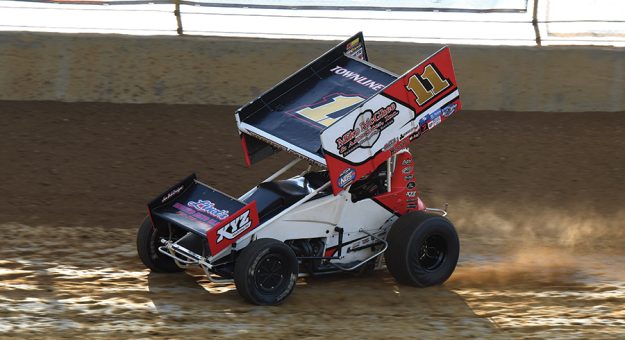As his stepson‘s racing career progressed, Ronk became more deeply involved in the sport as well. Ronk‘s main concern, H&R Industrial focuses on steel fabrication. He purchased Chalk Racing Products and later acquired Schroeder Torsion Bars.
Because these ventures were added to Ronk‘s plate, Kami walked away from nursing to oversee these new holdings. Perpetually restless, Ronk started a titanium business on the side and as a result struck up a relationship with Brady Bacon.
Given the depth of his experience, Bacon became an important mentor to the family of relative newcomers to the sport. In 2012, they sold their micro inventory and Price-Miller did a three-week unpaid internship of sorts under Bacon. Through this partnership, Ronk purchased a used roller chassis from Brady and then secured a 410 engine from open-wheel legend Gary Wright.

At 14 years old, Price-Miller was prepared to wheel a traditional sprint car on the Indiana bullrings.
By 2013, Price-Miller was getting a feel for sprint cars but also had a productive season with the POWRi Midget Series, finishing sixth in points and earning rookie-of-the-year honors. He won his first midget race at Indiana‘s Montpelier Motor Speedway, but he truly turned heads when he was the fast qualifier during the Turkey Night Grand Prix at California‘s Perris Auto Speedway.
He carried that momentum into 2014 where he was the rookie of the year during the Chili Bowl Nationals. Shortly, thereafter, he headed to Florida to race 360 sprint cars at East Bay Raceway Park.
In retrospect, the Florida trip served as a bit of a turning point in his career and his first nudge in a new direction.
“We were going to run at East Bay, just me and my dad,” Price-Miller recalled. “Rick Ferkel was working with Christopher Bell on the No. 83 Janet Holbrook car and it wasn‘t working out at Volusia, and they ended up parting ways. Christopher called me and said, ‘Hey my team just got rid of Rick.
You need to call him and have him help you at East Bay. He will get your stuff really good.‘
“This was the third or fourth wing race of my life, so my dad calls Rick and he said, ‘Let‘s go to practice night and see how it goes.‘ We went to practice night and I thought it went OK and Rick liked what he saw. He said, ‘Let‘s race, see how it goes and go from there.‘ So, the first night we won and we did well all week.”
The relationship continued through the rest of the year.
“When I first got into racing, I knew who Steve Kinser was and I knew who Joey Saldana was,” Price-Miller added. “But I didn‘t know who Gary Bettenhausen was or Rick Ferkel. It is hard to pinpoint when I really understood who Rick was. I learned a lot from him. He would not let me make an excuse. He would grab my arm and say, ‘Drive hard,‘ and he would know if I was driving the car hard or not. At that time, it was just me and my dad and my dad had never raced sprint cars. Sometimes we weren‘t on the same page.
“It was like trying to read a book blind. While I didn‘t use the same terminology as Rick, he could translate what I was saying. He would ask, ‘Are you sure you aren‘t feeling this?‘ Or suggest I pay attention to this. It helped me develop as a driver. I still talk to him two or three times a week.”
But Price-Miller‘s midget racing obligations were filling his schedule and something that happened behind the scenes changed the trajectory of his career.
As a promising young talent, Price-Miller was supported by Toyota and his contract stipulated that he attend every USAC race. Yet, looming ahead was a date at the Belleville High Banks in Kansas. Price-Miller had never taken on a track quite like Belleville or even raced on a half-mile track. Scott Ronk wasn‘t having it.
“Everybody who knows me in racing knows I‘m outspoken, but if I say I am going to do something I do it,” Ronk said. “I told them there was no way I was taking my kid there. I said my kid is 15 and I‘m the one that has to make the decision for him.”
